
In the world of language acquisition, comprehensible input is king. Comprehensible input refers to language that is easily understood by the learner, even if they don't understand every single word. It is the key to helping students acquire language naturally and effectively. One powerful way to provide comprehensible input is through the use of one-verb stories, also known as highly-focused stories that zero in on a single verb at a time. By focusing on just one main verb, teachers can help students maximize their acquisition of that verb and the language structures surrounding it.
The Rationale Behind One-Verb Stories
Traditionally, when we ask a story in the classroom, we tend to focus on three different verbs. This approach works well in many cases, as it allows students to engage with a variety of language structures and vocabulary. However, there are times when it may be more beneficial to laser in on just one verb. This might be the case when a particular verb is especially difficult for students, when it is critical for understanding a certain concept or topic, or when students frequently make errors with that verb.
Additionally, when we try to focus on three verbs at once, we may not be able to give each verb the attention it deserves. By spreading our focus too thin, we risk not hitting any of the verbs effectively. In these situations, one-verb stories can be the perfect solution.
The Benefits of Focusing on One Verb at a Time
When we target just one main verb in our stories, students are able to focus their attention and acquire that verb more easily. This doesn't mean that we can only use one verb throughout the entire story. Rather, it means that we are emphasizing one particular verb and crafting most of our questions and interactions around it.
By narrowing our focus, we allow students to acquire language more efficiently and with less effort on their part. They will still be exposed to a wide range of nouns, adjectives, adverbs, pronouns, and other verbs that make up the story. However, by highlighting one verb in particular, we give students the opportunity to really internalize its meaning and usage.
Setting the Stage for Success
To begin a one-verb story, start by writing the target verb on the board in first, second, and third person forms, along with their translations. It's important to write them in the order that you'll be using them in the story, rather than in a typical verb-chart order. We want to avoid having students memorize these verbs as a chart, as this can actually slow down the natural language acquisition process.
When writing the verbs on the board, use two different colors - one for the verb itself and another for its translation. This visual distinction can be especially helpful for visual learners and students with special needs, as it clearly separates the verb from its meaning.
It's crucial to remember that this is not the time for a grammar lesson. Resist the urge to explain the verbs in detail, their tenses, or whether they are regular or irregular. Instead, let the words and their translations speak for themselves. Allow students to make their own connections and form their own understanding of how the language works. As they are exposed to more and more language input, they will naturally refine their mental map of the language based on their growing proficiency.
Crafting the Story Through Questioning
Once you have your target verb written on the board, it's time to start developing the story. The key here is to put the work on the students to create the story, while you serve as a facilitator, asking leading questions to help them build a character and plot around your focus verb.
Some questions you might ask include:
- Who does the verb?
- When do they do the verb?
- Where do they do the verb?
- What do they do?
- How do they do the verb?
- Why do they do the verb?
The goal is to ask a wide variety of questions and to review frequently. As you ask questions, be sure to include individual students, the class as a whole, and yourself. This ensures that you are working the verb to its maximum potential in all its forms and in a natural context.
For example, you might ask:
- Do you do the verb?
- Do they do the verb?
- When do I do the verb?
Whenever you use a verb form that is not already written on the board, add it along with its translation. This way, students have a visual reference for all the different forms of the verb as they are used in context.
While asking questions to the whole class is important, don't forget to engage individual students as well. This can help you get more ideas and ensure that even quieter students are actively participating in the story creation process.
Reinforcing Learning Through Writing and Discussion
The day after introducing your one-verb story, it's a great idea to do a write and discuss activity with your students. This involves asking questions to review the story and writing the story on the board as students copy it down in their notebooks.
As with the initial story creation, be sure to ask questions to the whole class and to individual students. This will give you a comprehensive understanding of how well your students are comprehending the story and the target verb.
Incorporating dialogue into your write and discuss is another effective way to practice the different verb forms. The more dialogue you include, the more opportunities students have to see and use the verb in context. This is how they truly acquire the verb - not by memorizing a chart, but by engaging with it in meaningful ways.
Extending the Learning
Once you've completed your one-verb story and write and discuss activity, there are several ways you can extend the learning even further.
One option is to have students read and translate the write and discuss story to their family members or challenge them to tell an entirely new story based on the focus verb.
Another idea is to make the focus verb the centerpiece of a weekly quick write. Encourage students to write a story using the verb as much as possible in a natural way, and offer a prize to the student who uses it the most effectively.
You can also have students retell the story or create a new one based on the focus verb using a tool like Flipgrid. This is a fantastic way to assess students' overall speaking proficiency and see how well they are able to apply the verb in their own language production.
The Versatility of One-Verb Stories
As you can see, one-verb stories are not only powerful tools for language acquisition but also incredibly versatile. They can be adapted to suit the needs of different learners, used to target specific language structures, and extended in a variety of ways to reinforce learning.
By focusing on just one verb at a time and providing ample opportunities for students to engage with that verb in context, teachers can help students maximize their verb acquisition and overall language proficiency.
So, if you haven't tried a one-verb story in your classroom yet, why not give it a shot? You might be surprised at just how effective this approach can be in helping your students acquire language naturally and efficiently. And don't forget to share your experiences with other educators - we can all learn from each other's successes and challenges in the world of comprehensible input and language acquisition.
Key Takeaways
- One-verb stories, or highly-focused stories that focus on a single verb, are a powerful tool for providing comprehensible input and maximizing verb acquisition in language learners.
- By focusing on just one main verb, teachers can help students acquire the verb and its related language structures more effectively and efficiently.
- When introducing a one-verb story, write the target verb in different forms on the board with translations, and avoid explicit grammar explanations to allow for natural language acquisition.
- Develop the story by asking a variety of questions that put the work on the students to create the narrative while focusing on the target verb in different forms and contexts.
- Reinforce learning through write and discuss activities, and extend the learning by challenging students to create their own stories or retell the story using the focus verb in new contexts.
Have you taken our CI Proficiency Quiz yet? Find out where you are in your CI journey towards mastery. What are you waiting for?



